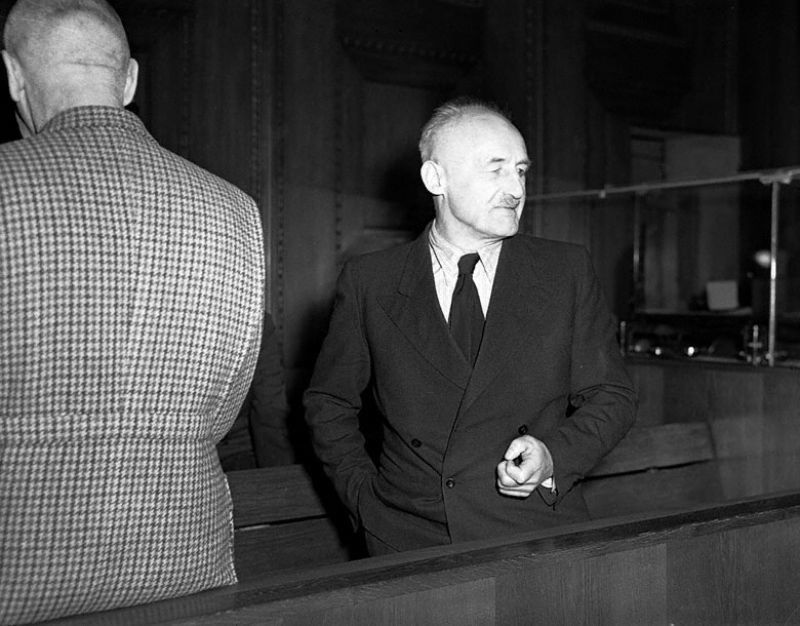Julius Streicher was the most notorious defendant at the Nuremberg Trials. As Gauleiter of Franconia, the region that included Nuremberg, he became infamous for violence, debauchery, and financial fraud, and his anti-Semitic newspaper “Der Stürmer” disgusted even the Nazi elite. Hitler’s patronage was the only reason why Streicher hadn’t been executed during the time of the Third Reich.
From Anti-Semitism to Nazism
Julius Sebastian Streicher was born on 12 February 1885 in the Bavarian village of Fleinhausen. He was the ninth child of a Catholic primary school teacher and even taught in school himself for a time.
Before the outbreak of World War I, Streicher served as a volunteer for a year, but was expelled from the Army for extreme indiscipline, as a result, his military service record was marked by a permanent ban on serving in the German Armed Forces. However, the war expiated the sins of the preceding year, since he proved himself to be a brave soldier and was awarded Iron Crosses of the 1st and 2nd Classes and received the rank of lieutenant.
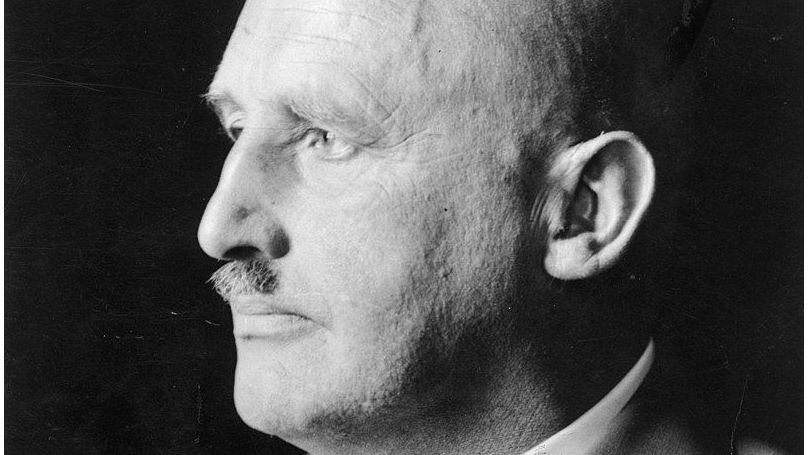
After the war, Streicher settled in Nuremberg and continued to work as a school teacher, but also started to participate in the county’s political life. In 1919, he created a branch of the far-right German Socialist Party (DSP) in Nuremberg, which promoted anti-Semitism.
Two years later, some members of the National Socialist German Workers' Party (NSDAP), who accused Adolf Hitler of dictatorship, tried to contact the DSP. This sparked a conflict within the party, but Hitler maintained his position and Streicher was able to find common ground with him. It didn’t matter to the future Führer who surrounded him, as long as they served the common cause. On 8 October 1922, Streicher joined the NSDAP, along with other DSP members.
Backstreet Tales
On 16 April 1923, he started the newspaper Der Stürmer (literally “The Stormer / Attacker / Striker”), which became known as the most "virulently" anti-Semitic newspaper in Germany. Most of the articles were written by Streicher himself, who was not ashamed of anything. He frequently accused Jews of “blood libel” – ritual killings of “Aryan” children by Jews; he published letters from an asylum patient complaining that Jews had put him there, as well as a list of names of girls who had danced with Jewish boys. He issued dirty tales and overtly pornographic caricatures. At the same time, Streicher tried to give anti-Semitism an “academic” connotation, appealing to a pseudoscientific theory of telegony: if a Jew was the first man of an “Aryan” woman, she would never be able to give birth to healthy and racially “clean” children.
Typical headlines were: “Jews defiling the race at work”, “Non-Jewish 15-year-old girl raped”, “Dangerous race defiler”, “He regards German woman as his prey”, “Jewish institute cultivates race defilement”, “Rape of feeble-minded girl”, “Jewish lackey steals from his Jewish landlords and commits race defilement”. Der Stürmer was never the official mouthpiece of the Nazi Party, but in the mid-1930s the newspaper’s circulation reached nearly half a million copies, and it was displayed at stands all over Germany.
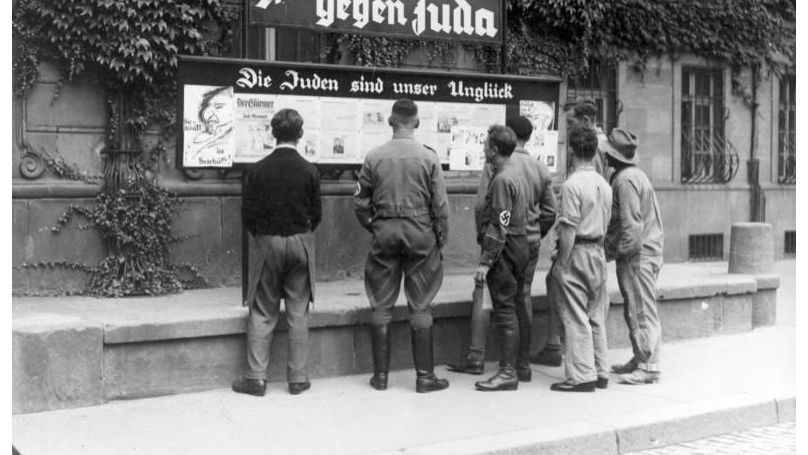
“The case against this defendant can be, perhaps, described by the unofficial title that he assumed for himself as ‘Jew-baiter Number One’. It is the Prosecution's case that for the course of some 25 years this man educated the whole of the German people in hatred and that he incited them to the persecution and to the extermination of the Jewish race. He was an accessory to murder, perhaps on a scale never attained before”, John Griffith-Jones, junior counsel for the United Kingdom, noted at the Nuremberg Trials.
Führer's Friend
On 8 November 1923, the “Beer Hall Putsch” took place, when the Nazis attempted to seize power in Munich. At the time, Streicher joined Hitler and marched alongside him in the front ranks. Some witnesses said that when the crowd of marchers was blocked by police, he was the first to shoot. The police responded by shooting 16 demonstrators. In the first salvos, the Nazi leader threw himself to the ground, with Streicher next to him.
“There may be one or two people who do not like the shape of Streicher's nose”, Hitler later explained. “But that day, as he lay beside me on the pavement of the Feldherrnhalle, I swore that I would not abandon him until he had abandoned me”.
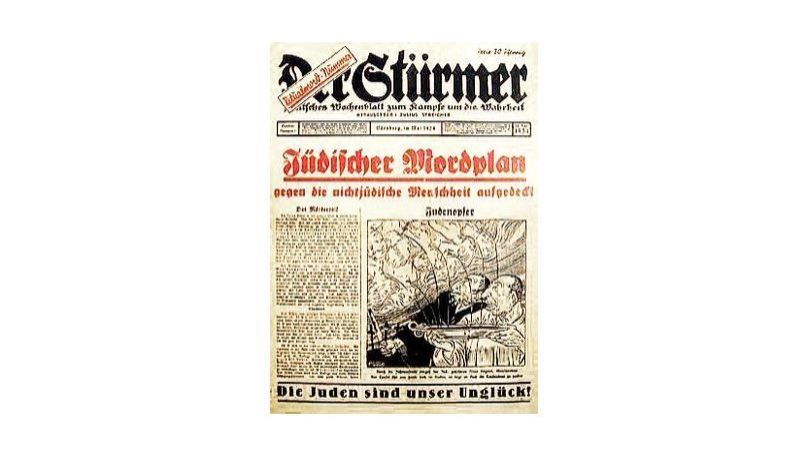
Hitler kept his promise. After a short time in prison, he in 1925 appointed Streicher as Gauleiter (leader of the party organisation) of Nuremberg. The latter was still teaching at the school, and obliged his pupils to greet him with “Heil Hitler!” Three years later, the school authorities became fed up with this and Streicher was fired for promoting anti-Semitic ideas.
But he concentrated on his career within the party. In 1929, he became Gauleiter of all of Franconia, and was elected to the Bavarian Landtag (state parliament) on behalf of the Nazis, and in 1933 he became deputy to the Reichstag from Thuringia. In 1934, Hitler promoted him to the rank of SS-gruppenführer (lieutenant general).
Gauleiter With a Bullwhip
In the Third Reich, Streicher's anti-Semitism was unleashed in full force. On 1 April 1933, he called for a boycott of Jewish businesses and chaired the Central Committee to direct this boycott. In 1935, he enthusiastically welcomed the adoption of the Nuremberg Laws on Citizenship and Race. In 1937, Streicher said: “The Jew always feeds on the blood of other peoples, he always needs killings and sacrifices. Victory will only come when the whole world is free from the Jews". On 10 November 1938, he stood up for Kristallnacht, a night of pogroms against Jews and Jewish property in Germany.
At the same time, a children's book called “The Fungi” was published by Der Stürmer, which explained that Jews were like poisonous mushrooms. Here is a typical fragment (remember, this was read by children):
“Inga has been waiting [for a doctor's appointment] for an hour now. She picks up the magazine again and tries to read. Then the door opens. Inga raises her head. A Jew appears. She screams, throws the newspaper down in terror and jumps up. She looks into the face of the Jewish doctor. It is the face of the devil. In the middle of this devil's face there is a huge hooked nose, behind [his] spectacles there are two frightening eyes, thick lips curved in a sneer. This sneer means: ‘Now you are in my hands, little German girl’. The Jew approaches her. He extends his greasy fingers towards her. But Inga has now come to her senses. Before the Jew manages to grab her, she stabs the fat face. She rushes to the door, panting, she runs down the stairs and escapes from the Jew's house”.
Meanwhile, the Gauleiter of Franconia's reputation was disgusting even by the standards of the Third Reich.
“A famous fornicator, as he boasted, who blackmailed even the husbands of women who were his mistresses, he made his fame and fortune as a blindly fanatical anti-Semite. His notorious weekly, Der Stürmer, thrived on lurid tales of Jewish sexual crimes and Jewish ‘ritual murders’; its obscenity was nauseating, even to many Nazis. Streicher was also a noted pornographist”, William Shirer, an American journalist, wrote.
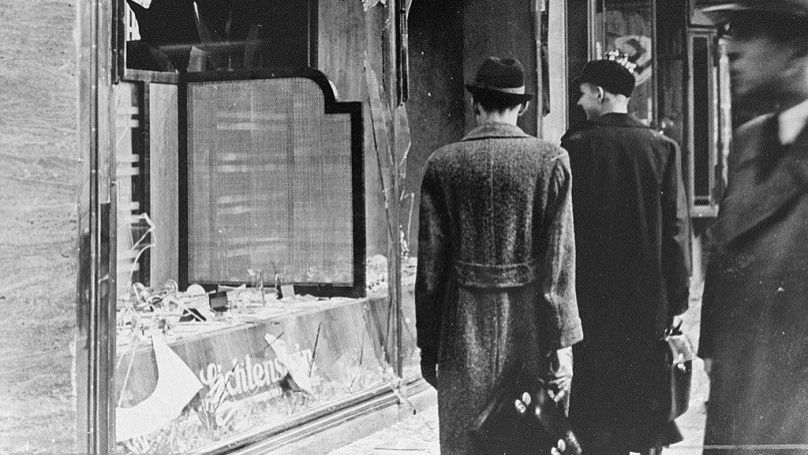
According to Shirer, “he became known as the ‘uncrowned King of Franconia’ with the centre of his power in Nuremberg, where his word was law and where no one who crossed him or displeased him was safe from prison and torture”. “Until I faced him slumped in the dock at Nuremberg, on trial for his life as a war criminal, I never saw him without a whip in his hand or in his belt, and he laughingly boasted of the countless lashings he had meted out”, the American journalist pointed out.
Within his Gau, he could do almost anything he wanted. On one occasion, Streicher beat a prisoner to a bloody pulp in a Nuremberg prison and then confessed to his staff: “I just needed this, now I feel much better”. It was also known that he was extremely greedy and bought confiscated Jewish property.
No wonder Streicher was criticised even by high-ranking party members. Hitler's closest associates – Hermann Göring, Reich aviation minister and president of the Reichstag, and Rudolf Hess, deputy Führer of the Nazi Party, as well as head of the German Labour Front Robert Ley and Hjalmar Schacht, president of the Reichsbank – openly declared that with his obscene articles and moral character, Streicher was doing Nazism far more harm than good. From 1938 onwards, his public appearances were banned by Reich Minister of Public Enlightenment and Propaganda Joseph Goebbels.
However, Hitler ignored these complaints about him for a long time. "I do not consider it the task of a political leader to try to improve the human material lying ready in his hands", said the Führer. In his view, a man from the grassroots had to learn about the "Jewish threat" in a simple and comprehensible way, and Der Stürmer was up to the task.
Luftwaffe Versus Der Stürmer
In 1940, Streicher's career was teetering on the brink. He was very unhappy that the Reich aviation minister had made a half-Jew, Field Marshal Erhard Milch, whose biography had been specially adjusted, his deputy. “I decide who is a Jew here”, Hermann Göring said. Such "freethinking" was unforgivable for Streicher and in one of Der Stürmer’s issues he called the daughter of the Luftwaffe chief, Edda, “a fruit of artificial insemination”.
The rumour was not of his own making. During that same “Beer Hall Putsch”, Göring had been shot in the groin, and there was talk that he would no longer be able to conceive children. But Streicher underestimated the reaction of Nazi No 2, who was desperate for his only child. A furious Göring demanded that Walter Buch, Supreme Party Judge [of the Nazi Party], punish the brazen scribbler. Buch promised to “stop this sick mind once and for all”.
Streicher was saved by Hitler's intervention. The Führer did not prevent a financial audit, as a result of which Herr Julius was removed from party office. But the former Gauleiter was able to save not only his life, but also the newspaper, which he continued to publish at an estate near Nuremberg.
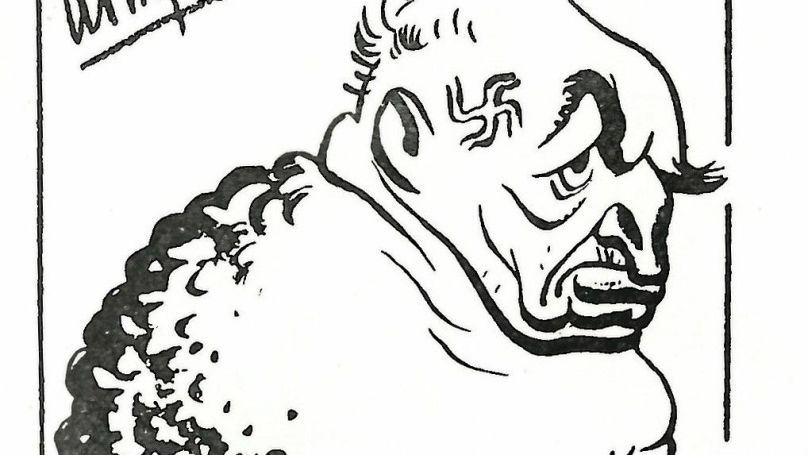
After the outbreak of World War II, Streicher proved to be an ardent supporter of the extermination of Polish and Soviet Jews. On 6 January 1944, he wrote in Der Stürmer: “The rise of National Socialism offers us the opportunity to liberate the continent from the Jewish enslavers and exploiters once and for all”. It was not until February 1945 that the newspaper ceased publication, at which time Streicher was restored from disgrace. In the last weeks of the war, he was again the de facto leader of the Franconian party organisation.
“It may be that this defendant is less directly involved in the physical commission of the crimes against Jews, of which this Tribunal have heard, than some of his co-conspirators. The submission of the Prosecution is that his crime is no less the worse for that reason. No government in the world, before the Nazis came to power, could have embarked upon and put into effect a policy of mass extermination in the way in which they did, without having a people who would back them and support them and without having a large number of people, men and women, who were prepared to put their hands to their bloody murder. And not even, perhaps, the German people of previous generations would have lent themselves to the crimes about which this Tribunal has heard, the killing of millions and millions of men and women.
It was to the task of educating the people, of producing murderers, educating and poisoning them with hate, that Streicher set himself; and for 25 years he has continued unrelentingly the education - if you can call it so - or the perversion of the people and of the youth of Germany. And he has gone on and on as he saw the results of his work bearing fruit”, Griffith-Jones stressed at the trials.
An Outcast Among Criminals
On 23 May 1945, Streicher was captured in the town of Waidring, Austria, by a group of American officers, and in November he was brought before the International Military Tribunal. Unlike the other defendants, he had been to the Nuremberg Palace of Justice before, when he was accused of child solicitation, but acquitted.
Streicher was the only defendant, not counting Friche, who was not charged with actual activities, but with propaganda.
“He promoted the accession to power of the Nazi conspirators and the consolidation of their control over Germany set forth in Count One of the Indictment; he authorized, directed, and participated in the Crimes against Humanity set forth in Count Four of the Indictment, including particularly the incitement of the persecution of the Jews set forth in Count One and Count Four of the Indictment”, Sidney Alderman, associate trial counsel for the United States, noted.
“Streicher can be considered the true 'spiritual father' of those who tore children in two at Treblinka”, Roman Rudenko, chief prosecutor for the USSR, added. “Without Der Stürmer and its master, German fascism would not have been able to raise so quickly those large numbers of murderers who directly carried out the criminal plans of Hitler and his clique: the destruction of more than 6 million European Jews”.
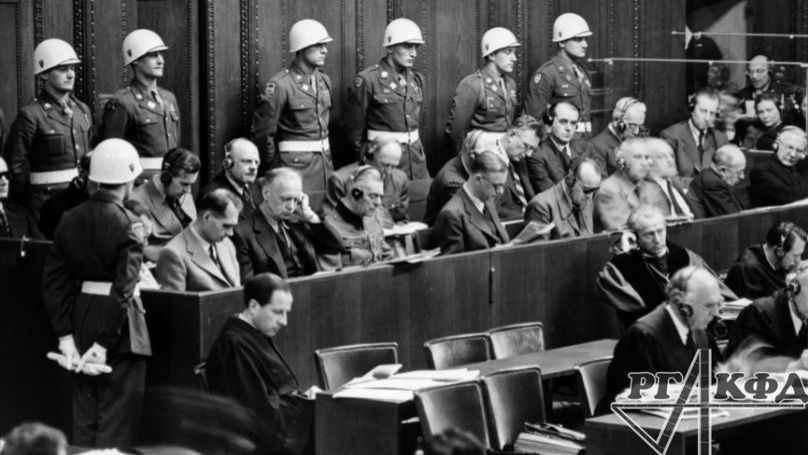
In response, Streicher said that “this trial is a triumph for World Jewry!” and denied the accusations against him. “The speeches and articles which I wrote”, he said, “were meant to inform the public on a question which appeared to me one of the most important questions. I did not intend to agitate or inflame but to enlighten”. He agreed that he had called for the eradication of the Jewish people, but "not in the literal sense", and admitted that he had read about the extermination of the Jews in foreign newspapers, but allegedly did not believe it himself.
Hans Marx, the lawyer representing Streicher, demanded a psychiatric examination, to which the defendant objected. The doctors found that Streicher was obsessive-compulsive, but generally healthy, sane, and capable of taking responsibility for his actions.
In the Palace of Justice dining room, which was divided into compartments for security purposes, Streicher was assigned to share a table with Hess, former Commander-in-Chief of the Navy Erich Raeder, and former Foreign Minister Joachim von Ribbentrop. As psychologist Gustave Gilbert testified, “the latter two sat with a hurt look, feeling humiliated at being forced to eat in the same room of such an odious figure as him [Streicher]”.
Sources:
Encyclopedia of the Third Reich
Constantine Zalessky. Who is who in the Third Reich. Bibliographic dictionary
Alexei Surin. Julius Streicher: Propaganda for Barbarism
William Shirer. The Rise and Fall of the Third Reich
Nuremberg Trials Stenograph, Volumes I, IV, V, Translated from English by Sergey Miroshnichenko.
By Daniil Sidorov
